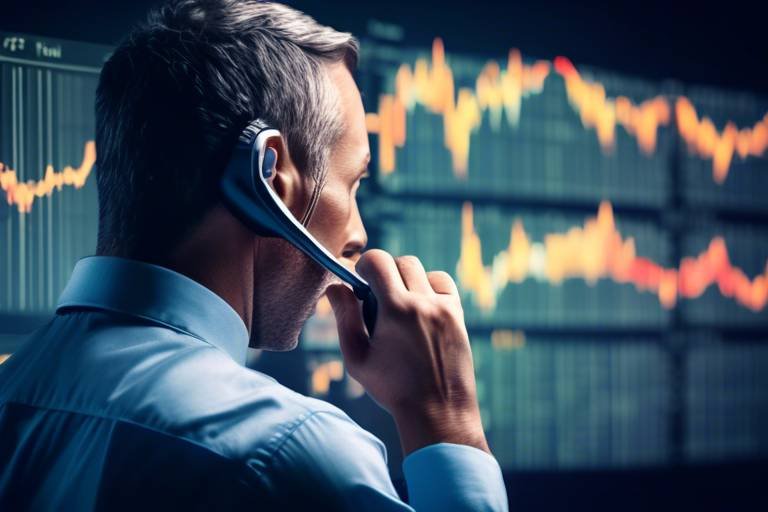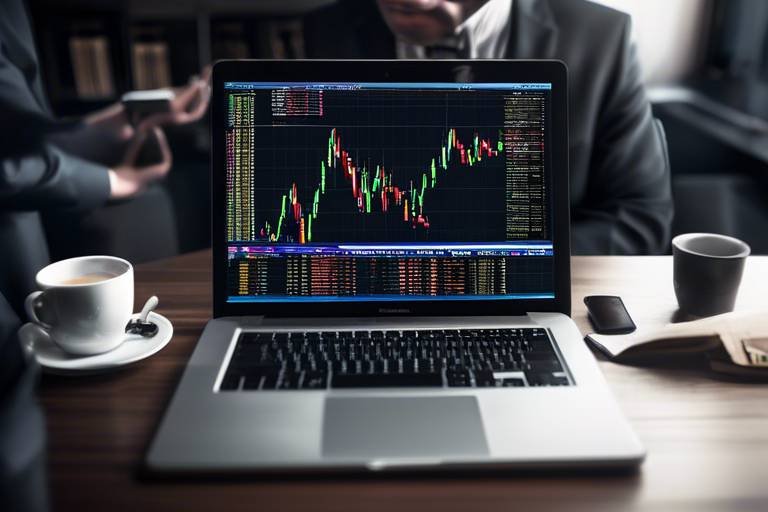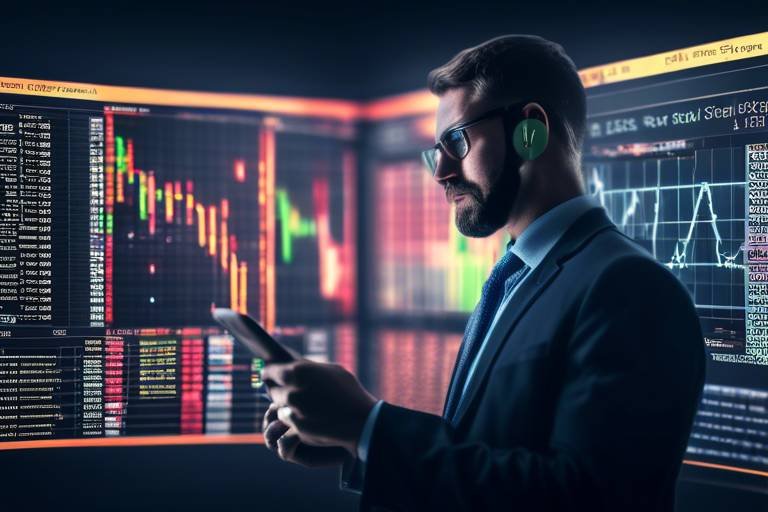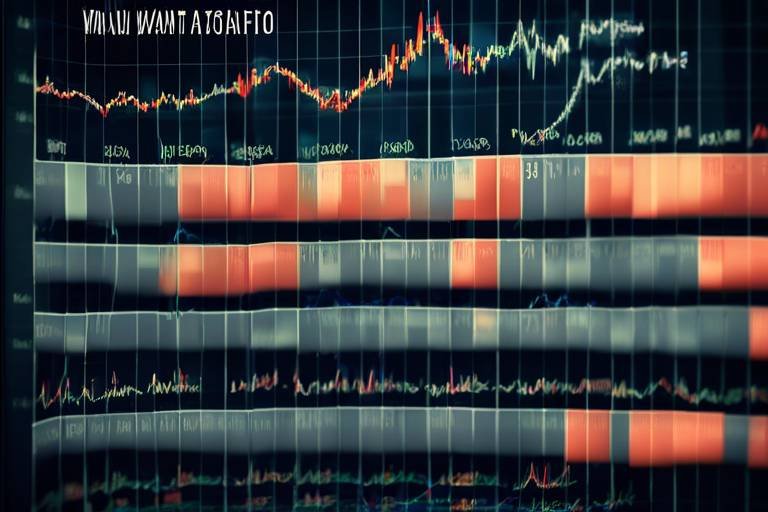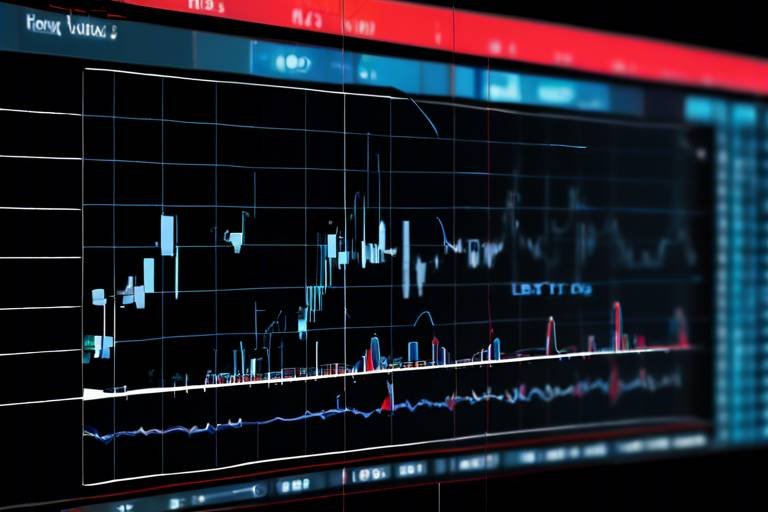The Role of Technology in Enhancing Trading Analysis
In today's fast-paced financial landscape, technology plays a pivotal role in transforming how traders analyze markets and make decisions. Gone are the days when traders relied solely on intuition and manual calculations; now, they have a wealth of tools at their fingertips that can elevate their trading strategies to new heights. From sophisticated software that processes vast amounts of data to real-time analytics that provide immediate insights, technology has fundamentally changed the trading game.
Imagine standing at the edge of a bustling marketplace, where every second counts, and every decision can lead to profit or loss. This is the reality for modern traders, who must navigate through a sea of information to find the best opportunities. With the advent of advanced trading platforms, traders can now harness the power of data analytics to sift through mountains of information, pinpointing trends and patterns that would be impossible to detect manually.
Moreover, the integration of automated trading systems has revolutionized the execution of trades. These systems operate on algorithms that execute trades based on predefined criteria, allowing traders to capitalize on market movements with lightning speed. This not only reduces human error but also enhances efficiency in trading operations, giving traders a significant edge in a highly competitive environment.
As we delve deeper into this article, we will explore the evolution of trading technology, the impact of data analytics, and the exciting future that lies ahead. Whether you're a seasoned trader or just starting, understanding the role of technology in trading analysis is essential for navigating the complexities of today’s financial markets.
The journey of trading technology is a fascinating one, marked by significant advancements that have shaped the way markets operate. In the early days, traders relied on manual methods, using pen and paper to track prices and execute trades. The introduction of the telephone revolutionized communication, allowing traders to place orders more efficiently. However, it was the rise of computers and the internet that truly transformed trading.
Modern digital platforms have made it possible for traders to access real-time data, execute trades instantly, and analyze market conditions with unprecedented accuracy. Today, traders can utilize tools such as charting software, which provides visual representations of market trends, and economic calendars that keep them informed about important market events.
This rapid evolution has not only improved the efficiency of trading but has also democratized access to financial markets. Individuals can now trade from the comfort of their homes, armed with the same tools that were once exclusive to institutional investors. As we look to the future, the possibilities for further advancements in trading technology are limitless.
At the heart of modern trading lies data analytics. The ability to interpret and analyze vast amounts of market data is crucial for traders seeking to gain an edge. With the explosion of information available today, traders must leverage analytical tools to make sense of it all. This involves identifying trends, understanding market sentiment, and making informed decisions based on statistical insights.
Big data refers to the massive volumes of data generated every second in the financial markets. By utilizing big data analytics, traders can process and analyze these large datasets to uncover valuable insights. This capability allows them to make better predictions and develop strategies that enhance their trading performance, particularly in volatile markets.
One of the most exciting advancements in trading analysis is the use of machine learning algorithms. These algorithms can identify patterns and optimize trading strategies by learning from historical data. As they evolve, they become increasingly adept at predicting market movements, enabling traders to make more accurate decisions.
Another powerful tool in the trader's arsenal is predictive analytics. By analyzing historical data, traders can anticipate market movements and make timely decisions. This proactive approach allows them to stay ahead of the curve, positioning themselves for success in an ever-changing market landscape.
In the world of trading, timing is everything. Real-time market analysis tools provide traders with immediate access to market data, enabling them to react quickly to changes. This capability is crucial in fast-paced trading environments, where a single moment can mean the difference between profit and loss.
Automated trading systems have become a cornerstone of modern trading strategies. By executing trades based on predefined criteria, these systems streamline the trading process and reduce the likelihood of human error. Traders can set parameters for their trades, allowing the system to operate autonomously while they focus on other aspects of their strategy.
Algorithmic trading offers numerous benefits, including:
- Speed: Trades are executed at optimal prices in milliseconds.
- Cost Minimization: Reduces transaction costs by executing large orders efficiently.
- Improved Performance: Enhances overall trading performance through precision and accuracy.
While the advantages of automated trading are clear, it is essential to acknowledge the risks involved. System failures, technical glitches, and market volatility can pose significant challenges. Therefore, traders must implement robust risk management strategies to safeguard their investments and navigate potential pitfalls.
As we look forward, the future of trading technology is bright. Emerging technologies such as blockchain and artificial intelligence hold the potential to further revolutionize trading analysis and market dynamics. Blockchain can enhance transparency and security in transactions, while AI can provide deeper insights and predictive capabilities.
In conclusion, the role of technology in enhancing trading analysis cannot be overstated. As traders continue to embrace these advancements, they will find themselves better equipped to navigate the complexities of financial markets, making informed decisions that lead to greater profitability.
Q1: How has technology changed trading analysis?
A1: Technology has introduced advanced tools and platforms that allow traders to analyze market data in real-time, automate trades, and utilize data analytics for better decision-making.
Q2: What are the benefits of using automated trading systems?
A2: Automated trading systems improve efficiency by executing trades based on predefined criteria, reducing human error, and allowing traders to capitalize on market opportunities quickly.
Q3: What role does big data play in trading?
A3: Big data analytics enables traders to process and analyze large volumes of market data, leading to better predictions and enhanced trading strategies.
Q4: What are the risks associated with automated trading?
A4: Risks include system failures, technical glitches, and market volatility, which require traders to implement robust risk management strategies.

The Evolution of Trading Technology
The landscape of trading has undergone a remarkable transformation over the decades, evolving from rudimentary methods to sophisticated digital platforms that dominate the financial markets today. In the early days, traders relied heavily on telegraphs and phone calls to communicate market information, often leading to delays that could cost them significant profits. Imagine trying to make a split-second decision based on a message that took hours to reach you! This inefficiency paved the way for innovations that would change the game forever.
As technology advanced, the introduction of computers in the 1980s marked a significant turning point. Traders began utilizing desktop applications that provided real-time data, enabling them to analyze market trends with unprecedented speed and accuracy. The rise of the internet in the 1990s further accelerated this evolution, allowing for online trading platforms that democratized access to financial markets. Suddenly, anyone with a computer and an internet connection could trade stocks, currencies, and commodities from the comfort of their home.
Today, we stand at the pinnacle of trading technology, where algorithmic trading and high-frequency trading (HFT) dominate the scene. These advanced systems leverage complex algorithms to execute trades at lightning speed, often in fractions of a second. This shift has not only increased the volume of trades but has also introduced new strategies that rely on data analytics and machine learning. Traders now have access to tools that analyze vast datasets, identify patterns, and execute trades automatically, making the trading process more efficient than ever before.
To illustrate this evolution, consider the following table that highlights key milestones in trading technology:
| Year | Milestone |
|---|---|
| 1867 | Invention of the telegraph, enabling faster communication. |
| 1980s | Introduction of personal computers for trading. |
| 1990s | Launch of online trading platforms. |
| 2000s | Rise of algorithmic and high-frequency trading. |
| 2020s | Integration of AI and machine learning in trading strategies. |
As we reflect on this evolution, it's clear that technology has not only enhanced trading analysis but has also reshaped the entire financial landscape. The ability to process information quickly and accurately has become a vital component of successful trading strategies. Today’s traders must be adept at using these technological tools to maintain a competitive edge. The question remains: what will the next chapter in trading technology look like? With emerging technologies on the horizon, the possibilities are endless, and the future of trading seems brighter than ever.

Data Analytics in Trading
In the fast-paced world of trading, data analytics has emerged as a game changer. It’s like having a crystal ball that allows traders to gaze into the future of market trends and make informed decisions. With the sheer volume of data generated every second in the financial markets, traditional methods of analysis simply can't keep up. This is where data analytics steps in, transforming how traders interpret vast amounts of information.
Imagine trying to find a needle in a haystack. That’s what it used to feel like for traders before the advent of data analytics. Now, with sophisticated tools at their disposal, traders can sift through mountains of data to find those golden opportunities. The ability to interpret data accurately means that traders can identify trends, spot anomalies, and make decisions based on statistical evidence rather than gut feelings.
There are several key components of data analytics that are particularly relevant to trading:
- Trend Analysis: By examining historical data, traders can identify patterns that often repeat, providing insights into future price movements.
- Sentiment Analysis: This involves gauging market sentiment through news articles, social media, and other sources to understand how public perception may impact market behavior.
- Risk Assessment: Analytics tools can help traders assess the potential risks associated with different trading strategies, allowing for more informed decision-making.
With the integration of big data technologies, traders can now analyze data sets that were previously unimaginable. For example, big data analytics enables the processing of information from various sources, including economic indicators, social media trends, and even weather patterns, to create a comprehensive view of the market landscape. This holistic approach empowers traders to develop strategies that are not only reactive but also proactive.
Big data analytics is revolutionizing trading performance. It allows traders to make sense of complex datasets and uncover hidden correlations. For instance, by analyzing historical trading data alongside current market conditions, traders can identify potential price movements with greater accuracy. This is particularly crucial in volatile markets where split-second decisions can lead to significant gains or devastating losses.
One of the most exciting developments in trading analytics is the use of machine learning algorithms. These algorithms can learn from historical data and identify patterns that human traders might overlook. By continuously analyzing new data, machine learning models improve their predictions over time, making them an invaluable asset in a trader's toolkit. It’s like having a super-smart assistant that never sleeps and is always learning.
Another powerful aspect of data analytics in trading is predictive analytics. This technique combines statistical algorithms and machine learning to forecast future market movements based on historical data. Traders can leverage these insights to anticipate price changes and make timely decisions that capitalize on market opportunities. In essence, predictive analytics serves as a guiding light, illuminating the path forward in the often murky waters of trading.
Finally, real-time market analysis tools have become indispensable for modern traders. These tools provide immediate access to market data, enabling swift decision-making. Imagine being at a racetrack, where every second counts; having real-time data is like having the best vantage point to see the race unfold. This capability allows traders to react quickly to market changes, ensuring they stay ahead of the competition.
In conclusion, data analytics is not just a buzzword in the trading world; it’s a fundamental shift in how trading is approached. By harnessing the power of data, traders can enhance their decision-making processes, improve efficiency, and ultimately increase profitability in the financial markets. The future of trading is undoubtedly intertwined with the advancements in data analytics, paving the way for smarter and more strategic trading practices.

Big Data and Its Impact
In today's fast-paced financial markets, big data has emerged as a game-changer for traders seeking to gain a competitive edge. The sheer volume of data generated every second—from stock prices to social media sentiment—can be overwhelming. However, with the right tools and techniques, traders can harness this data to make informed decisions that can significantly enhance their trading strategies. Imagine trying to find a needle in a haystack; that's what analyzing market data used to feel like before the advent of big data analytics. Now, it's like having a magnet that pulls the needle right to you!
Big data analytics enables traders to process vast datasets quickly and efficiently. By leveraging sophisticated algorithms, traders can identify patterns and trends that were previously invisible. This capability allows them to predict market movements with greater accuracy. For example, a trader might analyze historical price data alongside current economic indicators to forecast future price trends. The ability to connect these dots can make all the difference in a trader’s bottom line.
Moreover, the impact of big data extends beyond just identifying trends. It also enhances risk management strategies. Traders can analyze historical data to understand how certain stocks react to market changes, helping them to develop strategies that mitigate risk. For instance, if a trader notices that a particular stock tends to drop significantly during economic downturns, they can adjust their portfolio accordingly to avoid potential losses. This proactive approach is akin to having an umbrella ready before the rain starts to pour.
To illustrate the significance of big data in trading, consider the following table that outlines key benefits:
| Benefit | Description |
|---|---|
| Enhanced Decision Making | Traders can make faster and more accurate decisions based on data-driven insights. |
| Trend Identification | Ability to spot market trends and potential opportunities before they become obvious. |
| Risk Management | Improved strategies to mitigate risks by understanding market behaviors. |
| Increased Profitability | Data-driven strategies can lead to higher returns on investments. |
In conclusion, the impact of big data on trading cannot be overstated. It has transformed the landscape of trading analysis, allowing traders to navigate the complexities of the market with greater confidence and precision. As technology continues to evolve, those who harness the power of big data will undoubtedly find themselves at the forefront of trading innovation.
- What is big data in trading?
Big data in trading refers to the vast amounts of structured and unstructured data that traders analyze to make informed decisions and improve trading strategies. - How does big data improve trading accuracy?
By analyzing historical data and identifying patterns, traders can make predictions about future market movements, enhancing their accuracy in trading decisions. - What tools are used for big data analytics in trading?
Common tools include statistical software, machine learning algorithms, and specialized trading platforms that can process large datasets efficiently.

Machine Learning Algorithms
In the world of trading, are akin to having a seasoned navigator in a stormy sea. They provide traders with the ability to sift through mountains of data, identifying patterns and trends that would be nearly impossible for a human to discern. Imagine trying to find a needle in a haystack; now, picture having a magnet that effortlessly pulls that needle out. That’s the power of machine learning in trading analysis.
These sophisticated algorithms analyze historical data and real-time market information, allowing traders to make decisions based on statistical evidence rather than gut feelings. By employing techniques such as supervised learning, unsupervised learning, and reinforcement learning, traders can develop models that predict price movements, assess risks, and optimize their trading strategies. For instance, a supervised learning model can be trained on past market data to predict future price trends, while unsupervised learning can help identify hidden patterns in trading behaviors.
One of the most exciting aspects of machine learning in trading is its ability to continuously learn and adapt. As new data comes in, these algorithms refine their predictions, becoming more accurate over time. This adaptability is crucial in the fast-paced world of financial markets, where conditions can change rapidly. Traders who harness this technology can gain a significant edge, as they are not only reacting to market changes but anticipating them.
However, it's important to note that while machine learning algorithms offer substantial advantages, they are not infallible. Traders must remain vigilant and understand the limitations of these models. For example, during unprecedented market events, like the sudden crash of 2008, even the most sophisticated algorithms can struggle to provide accurate predictions. Hence, a blend of human intuition and machine learning insights often yields the best results.
To illustrate the impact of machine learning algorithms in trading, consider the following table that outlines some common applications:
| Application | Description |
|---|---|
| Predictive Modeling | Utilizes historical data to forecast future price movements. |
| Sentiment Analysis | Analyzes news articles and social media to gauge market sentiment. |
| Risk Assessment | Evaluates potential risks based on market volatility and historical patterns. |
| Trade Execution | Automates trade execution based on predefined criteria to optimize entry and exit points. |
In summary, machine learning algorithms are transforming the landscape of trading analysis. They empower traders to make data-driven decisions, enhance their strategies, and ultimately increase their profitability. Yet, like any powerful tool, they require a thoughtful approach to ensure that traders can navigate the complexities of the market effectively.

Predictive Analytics
In the fast-paced world of trading, staying ahead of the curve is not just an advantage; it's a necessity. This is where comes into play. By leveraging historical data and advanced statistical techniques, predictive analytics enables traders to anticipate market movements and make informed decisions that can significantly impact their profitability. Imagine having a crystal ball that doesn't just show you the future but also guides you on how to navigate it. That's the power of predictive analytics in trading.
At its core, predictive analytics involves the use of various data sources to identify patterns and trends that can inform trading strategies. Traders analyze past market behavior, economic indicators, and even social media sentiment to forecast future price movements. This multifaceted approach allows them to create a comprehensive picture of market dynamics. For instance, a trader might notice that whenever a particular economic report is released, the market reacts in a specific way. By recognizing this pattern, they can position themselves advantageously before the report is published.
Furthermore, the integration of machine learning algorithms into predictive analytics has taken this practice to a whole new level. These algorithms can process vast amounts of data far beyond human capabilities, identifying subtle patterns that might go unnoticed. As they learn from new data, they continuously refine their predictions, making them increasingly accurate over time. This is akin to having a personal assistant who not only remembers your preferences but also learns from your past decisions to offer better advice in the future.
To illustrate the impact of predictive analytics, consider the following table that summarizes key factors influencing market predictions:
| Factor | Description | Impact on Predictions |
|---|---|---|
| Historical Data | Past market performance data used to identify trends. | Helps in recognizing recurring patterns. |
| Economic Indicators | Statistics such as GDP, unemployment rates, etc. | Provides context for market movements. |
| Sentiment Analysis | Analysis of social media and news sentiment. | Indicates potential market reactions based on public perception. |
In conclusion, predictive analytics serves as a vital tool for traders aiming to enhance their decision-making processes. By utilizing historical data, economic indicators, and advanced algorithms, traders can gain valuable insights into potential market movements. However, it's essential to remember that while predictive analytics can significantly improve trading strategies, no method is foolproof. The market is inherently unpredictable, and external factors can always influence outcomes. Thus, combining predictive analytics with sound risk management practices is crucial for long-term success in trading.
- What is predictive analytics?
Predictive analytics involves using historical data and statistical techniques to forecast future market movements. - How does predictive analytics improve trading?
It helps traders make informed decisions by identifying patterns and trends in the market. - Can predictive analytics guarantee profits?
No, while it can enhance decision-making, trading always involves risks and uncertainties. - What tools are commonly used for predictive analytics?
Common tools include statistical software, machine learning algorithms, and data visualization platforms.

Real-Time Market Analysis
In today's fast-paced financial landscape, has become a game-changer for traders. Imagine standing on a bustling trading floor, where every second counts, and the slightest delay could mean the difference between profit and loss. That's the reality traders face, and it's where technology steps in to save the day. With real-time data streaming directly to traders' screens, they can make swift decisions, capitalize on fleeting opportunities, and react to market changes like never before.
Real-time market analysis tools aggregate data from various sources, including stock exchanges, news outlets, and social media platforms, providing a comprehensive view of market sentiment. This capability allows traders to not only see current prices but also understand the underlying forces driving those prices. For instance, a sudden surge in trading volume might indicate a significant news event or a shift in market sentiment, prompting traders to adjust their strategies accordingly.
Furthermore, these tools often come equipped with advanced features such as technical indicators, charting capabilities, and alerts that notify traders of critical market movements. Traders can set up customized alerts to notify them when certain conditions are met, such as a stock reaching a specific price point or a moving average crossover. This level of customization ensures that traders can focus on what matters most to them, rather than sifting through mountains of data.
To illustrate the importance of real-time analysis, consider the following table that highlights key features and benefits:
| Feature | Benefit |
|---|---|
| Instant Data Updates | Allows for quick decision-making based on the latest market movements. |
| Custom Alerts | Enables traders to respond to market changes without constant monitoring. |
| Comprehensive Data Sources | Provides a well-rounded view of market conditions and sentiment. |
| Technical Analysis Tools | Helps traders identify trends and potential entry/exit points with precision. |
Moreover, the integration of artificial intelligence into real-time analysis tools has taken trading to new heights. AI algorithms can analyze vast amounts of data at lightning speed, identifying patterns and trends that human traders might miss. This not only enhances the accuracy of predictions but also allows traders to make data-driven decisions rather than relying solely on intuition.
In conclusion, real-time market analysis is not just a luxury; it's a necessity for traders who want to stay competitive in today's market. With the right tools, traders can harness the power of real-time data to make informed decisions, optimize their strategies, and ultimately enhance their trading performance. As technology continues to evolve, the capabilities of real-time analysis will only become more sophisticated, providing traders with even greater insights into the ever-changing financial landscape.
- What is real-time market analysis? Real-time market analysis refers to the immediate examination of market data to make quick trading decisions.
- Why is real-time analysis important? It allows traders to react swiftly to market changes, maximizing profit opportunities and minimizing losses.
- How do real-time analysis tools work? These tools aggregate data from multiple sources and provide instant updates, alerts, and analytical tools for traders.
- Can AI improve real-time market analysis? Yes, AI can analyze large datasets quickly, identifying trends and patterns that enhance trading strategies.

Automated Trading Systems
In today's fast-paced financial landscape, have become a game-changer for traders looking to enhance their performance and efficiency. These sophisticated systems leverage technology to execute trades automatically based on pre-defined criteria, eliminating the need for constant human intervention. Imagine having a tireless assistant that works around the clock, analyzing market conditions and executing trades at lightning speed—this is what automated trading systems offer. They not only save time but also help traders capitalize on market opportunities that may be missed due to human limitations.
One of the key benefits of automated trading systems is their ability to minimize human error. In the heat of the moment, emotions can cloud judgment, leading to impulsive decisions that may not align with a trader's strategy. By relying on algorithms and predefined rules, these systems execute trades with precision, ensuring that decisions are made based on data rather than emotions. This is particularly crucial in volatile markets where every second counts. For instance, an automated trading system can quickly react to sudden price changes, executing trades in milliseconds, which would be impossible for a human trader to achieve.
Furthermore, automated trading systems can analyze vast amounts of data in real time, allowing traders to identify trends and patterns that may not be immediately apparent. For example, consider a trader who uses a system that monitors multiple markets simultaneously. This system can detect correlations between different assets and execute trades based on those insights. The ability to process and analyze data at such a scale is a significant advantage in today's data-driven trading environment.
However, while the advantages of automated trading systems are compelling, they also come with their own set of challenges. Traders must be aware of the risks associated with these systems, including potential system failures and market volatility. A malfunctioning algorithm can lead to unintended trades, resulting in significant financial losses. Therefore, it is crucial for traders to implement robust risk management strategies. This can include setting stop-loss orders, regularly monitoring system performance, and maintaining a diversified portfolio to mitigate potential losses.
To illustrate the effectiveness of automated trading systems, consider the following table that compares traditional trading methods with automated systems:
| Feature | Traditional Trading | Automated Trading Systems |
|---|---|---|
| Execution Speed | Slower, dependent on human reaction time | Instantaneous, executes trades in milliseconds |
| Emotional Influence | High, can lead to impulsive decisions | None, decisions based on data and algorithms |
| Data Analysis | Limited, relies on manual analysis | Extensive, processes large datasets in real time |
| Risk Management | Manual, can be inconsistent | Automated, can include predefined risk parameters |
In conclusion, automated trading systems represent a significant evolution in the way trading is conducted. They offer numerous advantages, from enhanced execution speed to reduced emotional interference. However, traders must remain vigilant about the inherent risks and ensure that they implement sound risk management practices. As technology continues to advance, the role of automated trading systems will likely expand, paving the way for even more innovative trading strategies in the future.
- What is an automated trading system? An automated trading system is a software program that automatically executes trades based on predefined criteria without human intervention.
- Are automated trading systems suitable for all traders? While they can benefit many traders, those who prefer a hands-on approach or lack technical expertise may find them challenging to use effectively.
- What are the main risks associated with automated trading? Risks include system failures, market volatility, and the potential for unintended trades due to algorithm errors.
- Can I customize my automated trading system? Yes, many systems offer customization options, allowing traders to set their own strategies and parameters.

Benefits of Algorithmic Trading
Algorithmic trading has taken the financial world by storm, and for good reason. Imagine having a tireless assistant that works around the clock, analyzing market data and executing trades faster than any human could. That's the power of algorithmic trading! By leveraging complex algorithms and high-speed data processing, traders can achieve a level of efficiency and precision that was previously unimaginable. One of the primary benefits is the ability to execute trades at optimal prices. This means that traders can capitalize on market fluctuations in real-time, ensuring that they buy low and sell high, maximizing their profits.
Moreover, algorithmic trading reduces human error, which can often lead to costly mistakes. Think about it: when you're trading manually, emotions can cloud your judgment. Fear and greed often lead to impulsive decisions that can derail even the best strategies. With algorithms, trades are executed based on pre-defined criteria, eliminating emotional biases. This not only improves consistency but also enhances the overall trading performance.
Another significant advantage is the speed at which trades can be executed. In today's fast-paced markets, every second counts. Algorithmic trading systems can process vast amounts of information and execute trades in milliseconds, giving traders a competitive edge. This speed is particularly crucial during periods of high volatility, where prices can change rapidly. For example, during an earnings announcement or economic report, the market can react within seconds, and those who are not equipped with automated systems may miss out on lucrative opportunities.
Additionally, algorithmic trading allows for diversification across multiple markets and assets without the need for constant monitoring. Traders can set up their algorithms to trade various instruments simultaneously, spreading risk and increasing the potential for returns. This kind of diversification can be challenging for manual traders who may struggle to keep an eye on multiple positions at once.
However, it's essential to note that while algorithmic trading offers substantial benefits, it also requires a solid understanding of the underlying technology and market dynamics. Traders need to continuously monitor and tweak their algorithms to adapt to changing market conditions. A well-designed algorithm can be a trader's best friend, but a poorly designed one can lead to significant losses.
In summary, the benefits of algorithmic trading are numerous. From enhanced speed and efficiency to reduced human error and the ability to diversify, it's no wonder that more and more traders are turning to automated systems. As technology continues to evolve, those who embrace algorithmic trading will likely find themselves at the forefront of the financial markets.
- What is algorithmic trading?
Algorithmic trading refers to the use of computer algorithms to automate the process of buying and selling securities in the financial markets.
- How does algorithmic trading reduce human error?
By executing trades based on pre-defined criteria, algorithmic trading eliminates emotional biases and impulsive decisions that can result from manual trading.
- Can anyone use algorithmic trading?
While algorithmic trading is accessible to many, it requires a good understanding of programming, market dynamics, and risk management to be effective.
- What are the risks associated with algorithmic trading?
Risks include system failures, market volatility, and the potential for significant losses if algorithms are not properly designed or monitored.

Risks and Challenges
While the world of automated trading systems is undeniably exciting, it is not without its . One of the main concerns is the potential for system failures. Imagine relying on a sophisticated algorithm to execute trades only to find that a glitch has caused it to misinterpret market signals. Such scenarios can lead to significant financial losses in a matter of seconds. This is why it’s crucial for traders to have a robust contingency plan in place, ensuring that they can react swiftly to unexpected issues.
Another challenge is the inherent volatility of financial markets. Automated trading systems are designed to react to market conditions, but in highly volatile environments, these systems can sometimes exacerbate losses rather than mitigate them. For instance, during a sudden market crash, algorithms might trigger a series of sell orders, further driving down prices. This phenomenon, often referred to as a "flash crash," highlights the importance of incorporating risk management strategies into automated trading practices.
Moreover, traders must consider the complexity of algorithms themselves. While machine learning and predictive analytics offer incredible insights, they also require a deep understanding of both the technology and the market. Traders who lack this technical knowledge may find themselves at a disadvantage, unable to fully leverage the capabilities of their trading systems. This knowledge gap can lead to poor decision-making, as traders may not be aware of the limitations or biases embedded within their algorithms.
Lastly, the regulatory landscape surrounding automated trading is constantly evolving. Governments and regulatory bodies are increasingly scrutinizing algorithmic trading practices to ensure market fairness and transparency. Traders must stay informed about these regulations, as non-compliance can result in severe penalties, including fines or even bans from trading. It's essential to maintain a balance between leveraging technology and adhering to legal requirements.
In summary, while automated trading systems offer a plethora of benefits, they are not a one-size-fits-all solution. Traders must navigate a landscape filled with potential pitfalls, from technical failures to market volatility, and ensure that they are equipped with the necessary knowledge and strategies to mitigate these risks. As the trading environment continues to evolve, so too must the approaches traders take to harness the power of technology effectively.
- What are the main risks associated with automated trading?
Automated trading can lead to system failures, increased volatility, complexity in algorithms, and regulatory challenges. - How can traders mitigate risks in automated trading?
Implementing robust risk management strategies, staying informed about market conditions, and understanding the algorithms used can help mitigate risks. - Are there regulations governing automated trading?
Yes, various regulatory bodies oversee automated trading practices to ensure market fairness and compliance. - What should I consider before using automated trading systems?
Consider your understanding of the technology, your risk tolerance, and the current market conditions before diving into automated trading.

The Future of Trading Technology
As we look ahead, the landscape of trading technology is poised for a dramatic transformation, driven by innovations that promise to reshape how traders engage with the markets. The integration of blockchain technology and artificial intelligence (AI) is set to redefine traditional trading methods, enhancing transparency, security, and efficiency. Imagine a world where transactions are not only instantaneous but also carry an immutable record, ensuring trust among market participants. This is the future, and it’s closer than we think.
Blockchain technology, often associated with cryptocurrencies, offers a decentralized framework that can revolutionize trading by eliminating intermediaries. This means faster transactions and reduced costs. For instance, in a typical trading scenario, multiple parties are involved, leading to delays and increased fees. With blockchain, trades can be executed directly between buyers and sellers, streamlining the entire process. Moreover, the transparency of blockchain ensures that all transactions are verifiable, which can significantly reduce fraud and increase market integrity.
On the other hand, artificial intelligence is rapidly becoming a game-changer in trading analysis. AI algorithms can analyze vast amounts of data at lightning speed, identifying patterns that human traders might overlook. This capability not only enhances the accuracy of market predictions but also enables traders to make data-driven decisions in real-time. For example, AI can help in sentiment analysis, where it gauges market sentiment from news articles, social media, and other sources, providing traders with insights that can influence their strategies.
Moreover, the rise of quantitative trading strategies, powered by AI, is leading to a new era of trading where data is the king. Traders are increasingly relying on complex mathematical models to identify profitable opportunities. This shift is akin to moving from a traditional art form to a highly scientific approach, where every decision is backed by solid data. The ability to process and analyze big data in real-time means that traders can react swiftly to market changes, gaining a competitive edge.
However, with these advancements come challenges. The reliance on technology raises concerns about cybersecurity and the potential for systemic risks. As trading becomes more automated, the risk of technical failures or cyberattacks increases. Traders must be vigilant and implement robust risk management strategies to navigate this new terrain. It's essential to have contingency plans that can mitigate the impact of unforeseen events, ensuring that traders can adapt to rapidly changing market conditions.
In conclusion, the future of trading technology is bright, filled with opportunities that can enhance trading efficiency and profitability. As blockchain and AI continue to evolve, they will undoubtedly play a pivotal role in shaping the next generation of trading strategies. Traders who embrace these technologies will be better positioned to thrive in an increasingly competitive environment. The question remains: Are you ready to adapt to this exciting future?
- What role does blockchain play in trading technology? Blockchain enhances transparency and security in trading by eliminating intermediaries and providing a verifiable transaction history.
- How can AI improve trading strategies? AI can analyze large datasets quickly, identify patterns, and provide insights that lead to more informed trading decisions.
- What are the risks associated with automated trading? Risks include system failures, cybersecurity threats, and market volatility, necessitating robust risk management strategies.
- Will traditional trading methods become obsolete? While traditional methods may not become entirely obsolete, they will likely evolve and integrate with advanced technologies to remain competitive.
Frequently Asked Questions
- How has technology changed trading analysis?
Technology has revolutionized trading analysis by introducing advanced tools and platforms that allow traders to analyze vast amounts of data quickly and accurately. From algorithmic trading systems to real-time market analytics, technology empowers traders to make informed decisions, improving their efficiency and profitability.
- What is the role of data analytics in trading?
Data analytics plays a crucial role in trading by enabling traders to interpret large datasets, identify trends, and make decisions based on statistical insights. By leveraging data analytics, traders can enhance their strategies and adapt to changing market conditions more effectively.
- What is big data and how does it affect trading?
Big data refers to the massive volumes of data generated every second in the financial markets. By utilizing big data analytics, traders can process and analyze these large datasets to uncover hidden patterns and make better-informed predictions, ultimately enhancing their trading performance.
- How do machine learning algorithms improve trading?
Machine learning algorithms analyze historical data to identify patterns that humans might overlook. By continuously learning from new data, these algorithms can optimize trading strategies and improve the accuracy of market predictions, giving traders a competitive edge.
- What is predictive analytics in trading?
Predictive analytics involves using historical data to forecast future market movements. By analyzing trends and patterns, traders can anticipate changes in the market and make timely decisions to maximize their returns.
- Why is real-time market analysis important?
Real-time market analysis provides traders with immediate access to market data, allowing them to react quickly to price changes and market events. This speed is essential in fast-paced trading environments, where every second counts.
- What are automated trading systems?
Automated trading systems execute trades based on predefined criteria without human intervention. By reducing human error and increasing efficiency, these systems enable traders to capitalize on market opportunities more effectively.
- What are the benefits of algorithmic trading?
Algorithmic trading enhances trading strategies by executing orders at optimal prices, minimizing transaction costs, and improving overall trading performance through speed and precision. This approach allows traders to take advantage of market inefficiencies in real-time.
- What risks are associated with automated trading?
While automated trading offers many advantages, it also comes with risks, such as system failures, market volatility, and the potential for significant losses if not managed properly. Traders must implement robust risk management strategies to mitigate these risks.
- What does the future hold for trading technology?
The future of trading technology is bright, with emerging innovations like blockchain and artificial intelligence poised to further revolutionize trading analysis. These technologies have the potential to enhance transparency, security, and efficiency in financial markets.


